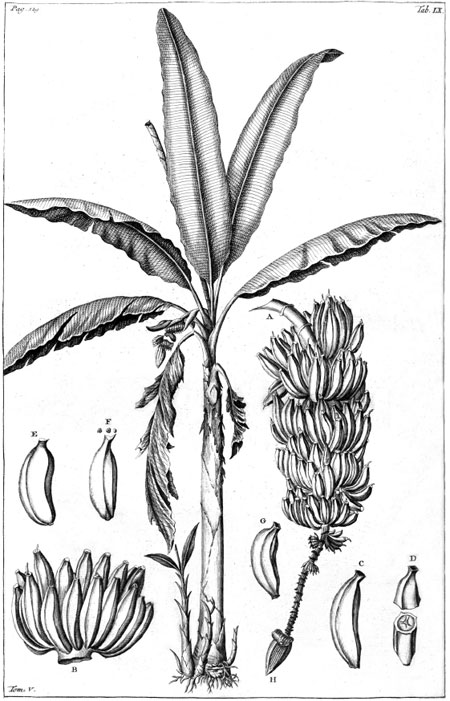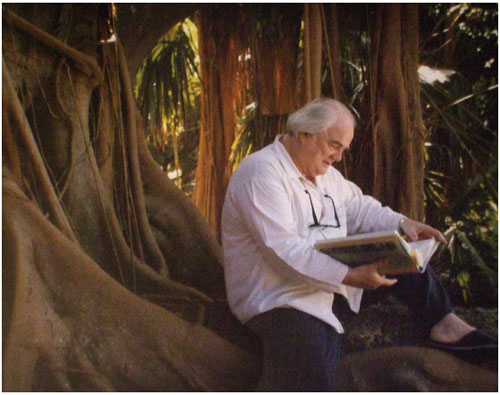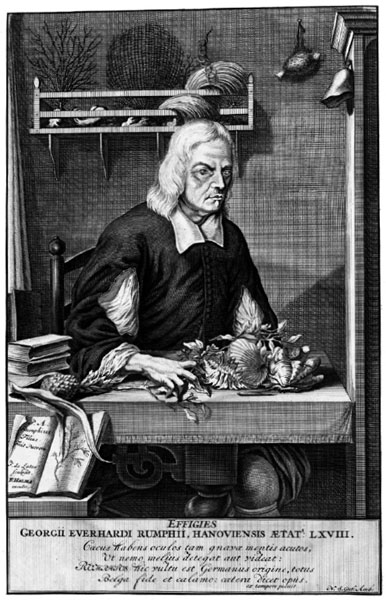The Herbal of Rumphius
By Peter H. Raven, Lynn Margulis
A 17th-century Dutch naturalist established the botanical foundations of the flora of Indonesia
A 17th-century Dutch naturalist established the botanical foundations of the flora of Indonesia

DOI: 10.1511/2009.76.7
From 1653 until his death in 1702—most of his adult life—Georgius Everhardus Rumphius lived on Ambon in eastern Indonesia, where he described its plants. At the time, Verenigde Oost-Indische Compagnie (the Dutch East India Company) was the largest private business enterprise in the world; it reflected the mercantile power of the far-flung Dutch Republic and controlled much of the trade between Europe, the “Spice Islands” and many ports of Asia. The Company headquarters at Ambon—one of the Molucca islands that are today part of Indonesia—became a bustling outpost of the “civilized world.” The contrast between the marum-grassy dunes, incessant booming waves, overcast skies, cold and damp cobbled streets of Amsterdam and the verdant, lush, mountainous backdrop of sunny warm Ambon was extraordinary. The paucity of useful species of flowering plants in the gloomy north contrasted with the prodigious green landscapes of Indonesia. The goal of Rumphius was not to bring himself fame or fortune but to communicate the wisdom of the place, to describe for the literate world the plethora of plants and their uses.

The colorful ways of natives, the abundance of fish and lack of meat, the soft tones of the many indigenous languages, the wafting odors of the sporulating molds and camellias, the ships, rafts and boats festooned with salty ropes and seaweeds, the beautiful diversity of sea shells—remains of myriad behaviors of life at the edges of the sea—all interested Rumphius. He was impressed and described the ways in which the ancient modes of life depended entirely on local habitat. The vegetation, diverse and overwhelming, that served nearly all the needs of the people is described in his great work, the “herbal.”
Beyond plants for food—grain and feed, fruit and nut—were plants to heal and to send the spirit soaring. Plants formed the basis of transport, of buildings, of parasols and of clothing. Orchids and bean pods, camellia teas and other stimulating and soothing infusions were the stuff of barter, of inebriation, of soothing infants and intestinal cleansing, of wound-healing, of dying cloth and of preparing fiber.
A former Hessian mercenary soldier, Rumphius saw clearly and early in his half-century stay that Ambonese habits were keyed closely to the tropical forest and seashore. Most of the people’s living and livelihood were bound to plants and algae. He collected copious notes on everything, especially the category that we call plant science: plant geography, floristics and ethnobotany. Rumphius recorded names and descriptions of more than 1,200 plants, of which nearly all are represented in his herbal.
“Natural History,” wrote Harvard psychologist William James more than 200 years later on an unspoiled continent unknown to Rumphius and his adopted compatriots, is the “simple duplication by the mind of a ready-made and given reality.” Such accurate and precise documentation of South East Asian “natural reality” and communication of it to ordinary people who might benefit from knowledge of the ages impelled the gargantuan force of Rumphius’s genius.
Rumphius’s 7-volume 7,000-page Ambon herbal, mainly of land plants, with each entry accompanied by a name in Latin, 17th-century Dutch, Malay, Chinese and, most importantly, local vernacular, is virtually unknown to botanists and other scientists of the “civilized world” today. Never before the recent extraordinary translation and commentary by the late Eric Montague Beekman has the work been available in English. Modern science has much to learn from Rumphius’s magnum opus. His verbal descriptions of etchings still open for us moderns the practical use of the 1,200 entries.

Photograph courtesy of E. M. Beekman.
Plant stuffs were employed in many ways: fence posts, lunt, kindling, food and feed, hallucinogens, dyes, clothing, fiber, cordage, ampules, ebullients, twine, housing and furniture, other building materials and so forth. Healing and medicinals included treatment for venereal disease and abortants to terminate pregnancy.
Our respect soars for the wisdom and skills of the indigenous peoples of present-day Indonesia as we encounter the accumulation of botanical knowledge already chronicled by Rumphius during his half-century in Ambon. We note that, nearly alone in his scholarly pursuits, he organized his description in a modern way. Plant entries are ordered into groups mainly by their reproductive structures (flowers, fruits, seeds or lack of them). Today botanists use these criteria to recognize botanical inclusive taxa. Plant “phyla,” “orders” and especially “families” such as Graminae or grasses, Leguminoseae (peas and beans with their two-seamed pods), Liliaceae (such as onion and garlic), Rosaceae (pears, apples, plums, roses, almonds …) provide the bases for groupings.
Surprisingly close to his material, Rumphius used the flower-fruit classification scheme still so appropriate. Indeed, he continued a version of the “binomial nomenclature” (Genus species) naming-of-organism scheme whose origin is universally attributed to Carl von Linné (Carolus Linnaeus), the Swede from Uppsala. Although somewhat looser in format and less strictly limited to only two terms (Genus species, then the scientist credited with the plant discovery), many binomial or trinomial-style names were used in the 17th century by Rumphius (and even some predecessors). Beekman makes clear that the great life-form naming tradition adopted by the Latin-literate world of science preceded the 18th century. The immensely detailed Ambon work, long after Rumphius’s death but prior to its publication, was “borrowed“ for botanical taxonomy and nomenclature by the ambitious Swede. Linnaeus especially used Rumphius’s tropical botany notes. Indeed, during the lengthy delays and spurts of Rumphius’s publication (in Amsterdam 50 years after his death), Linnaeus, the “moth-eaten student,” lived in the house of Johannes Burman, who enjoyed access to the immense herbal manuscript. Apparently Linnaeus, who described 10,000 plants in his Systema Naturae, “borrowed” from the great Ambonese-Dutch scholar with impunity!
By comparing extant modern Ambon plant cover to that described in Rumphius’s opus, estimates can be made of the pace of decimation, habitat destruction and extinction in the past 400 years near the old haunt. In the proximity of his compound the botanically depauperate surroundings may be compared with the immense plant diversity on the less-settled slopes above. Such observations support Beekman’s claim that Rumphius’s prodigious gift to modern science is of great value, as it is to human history as well.
Rumphius founded far more than ethnobotany. The details he accumulated inform history, philosophy, ecology, several other botanical fields, medicine, natural-product chemistry and the botanical origins of many modern industrial processes. He provides potential practical guides to the discovery of medicinals new, not to people but to pharmacological and chemical companies. With Beekman’s informed translation, the whole natural world of the Spice Islands is newly opened up.
Unlike those handling this vast subject today, Rumphius was a holistic thinker who made an extraordinary attempt, ultimately successful, to impart practical alleviation of physico-spiritual ailments and quotidian knowledge to ordinary families. He became an advisor to the women healers who ultimately sought him as a source of knowledge. The Dutch-Indonesian Malay culture in which he practiced became more Asian and less European through his work. Surgery or other invasion of the body he rejected as ineffective barbarism, as did his adopted countrymen. Unlike the surgeons of Le Havre, Amsterdam and Antwerp, the holistic thinker Rumphius deeply respected the life of the spirit. The penetration of the skin to breach the continuity of the whole mind-body was philosophical anathema. Plant leaves, flowers, bark or root extracts were applied to the skin as poultices or drunk as infusions. Practical details for sexual soothing, modes of abortion and even infanticide, infant and nipple sunscreen and other skin protection, stomach calming, antidiarrhetics, treatment of scabs and wounds and the like were communicated to both sufferers and healers frankly, swiftly and effectively. Efficacy was the goal: No esoteric privileged class gained by exploitation of the ill.
We must accept that, for at least the tropics, Rumphius deserves much of the fame now accorded to Linnaeus. Yet without multiple acts of wisdom and dedication, the wealth of Rumphius could have been lost to all. The entire original manuscript en route from Ambon to the Dutch publisher was lost at sea, the victim of a French squadron, when Rumphius was in his sixties. Fortunately, Joannes Camphuys, Governor General of the Company, had paid for a private copy of the first six books of the herbal for his own delectation, which, by this happenstance, became the only surviving text; the dramatic story of the entire herbal tells us very clearly how important to the future of culture are generous acts of public service.
Blinded, probably by cataracts, separated permanently for half a century from his place and people of origin until he died at the age of 72 in 1702, and with the inestimable aid of his common-law wife Susanna, this indefatigable Dutch genius showed the rest of the world such a rich tropical natural history that he founded several academic fields (for example, economic botany, tropical forest taxonomy and ethnographic documentation) before they reached the status of “field of study!”
Working alone for more than seven years with the invaluable support of the National Tropical Botanical Garden and on a Guggenheim Fellowship (2001) that barely financed one year, Professor Beekman himself, like his object of study Georgius Everhardus Rumphius, astounds us. His unique linguistic abilities (aside from fluency in Latin, Dutch, German and English, he was an accomplished poet), his perseverance, intelligence and newly acquired botanical expertise, are requisite to this work. We suspect the timing was optimal; it is unlikely that anyone else was competent and generous enough to complete this enormous undertaking.

It is E. M. Beekman’s labor of love that finally disseminates the efficacious, popular yet scholarly knowledge of Rumphius to so many of us nature-loving Anglophones such that neither the natural history nor the future of botany will be the same. In its current form, no doubt, the entire seven-volume work will be a necessary acquisition for arboreta, herbaria, horticultural, medical and paleontological museums, and all science libraries. We are likely also to see specialized derivative books and articles sprout from Beekman’s giant seed like that of the orchids of Rumphius already published in 2002.
We are grateful, as we suspect you will be, for the existence of the translation and commentary on the Dutch 17th-century work by Rumphius. We welcome with delight the completion of this 21st-century work of nearly the same scholarly magnitude by our late University of Massachusetts–Amherst colleague.
Click "American Scientist" to access home page
American Scientist Comments and Discussion
To discuss our articles or comment on them, please share them and tag American Scientist on social media platforms. Here are links to our profiles on Twitter, Facebook, and LinkedIn.
If we re-share your post, we will moderate comments/discussion following our comments policy.